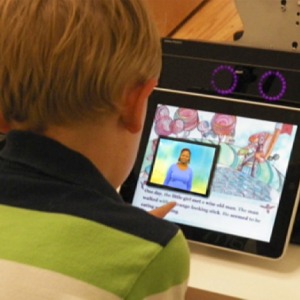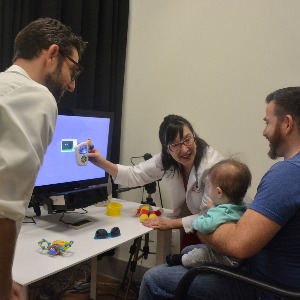Revolutionizing the Science of Learning



In February, renowned neuroscientist Dr. Laura-Ann Petitto made a revolutionary declaration to an audience of scientists, educators, and policymakers at a prestigious National Science Foundation event: Signed languages are biologically equivalent to spoken languages and are a biological necessity for young deaf children.
Petitto NSF presentation YouTubeThe cognitive benefits of a visual language are so significant and so lasting that it is imperative to expose deaf babies to sign language early in life lest they lose these advantages needed to build a strong language foundation, Petitto said during a NSF Science of Learning Centers Awardees Meeting on February 9 in Arlington, Virginia.
"Young children with early exposure to a visual language show advantages over other children in many areas and the same benefits as other bilinguals," said Petitto, co-PI and science director of the NSF Center on Visual Language and Visual Learning, VL2, and scientific director of her Brain and Language Laboratory for Neuroimaging, BL2.
"They have stronger visual attention skills and better vocabulary, higher cognition, language, reading, and self-regulation skills than non-sign-exposed deaf children, with some reading and language abilities exceeding hearing monolingual children," Petitto said.
This statement results from the convergence of Petitto's decades of research in neuroscience and language acquisition with VL2 research on literacy and visual learning.
Building a critical mass of research
When Petitto came to Gallaudet in 2010, she brought with her a wealth of findings that built on her work in the 1970s with Dr. William Stokoe on sign language phonology in linguistics.
Over the next three decades, Petitto expanded her focus to the biological foundations of sign language phonology in the brain. She made first-time discoveries that included findings about developmental milestones, key areas of the brain used for language processing, and the rhythms and patterns that make up the phonological level of organization of both signed and spoken languages.
Numerous studies by other scientists replicated and supported these findings.
- Girl signingDeaf infants exposed to sign language hit all of the same developmental milestones as hearing children. Petitto was also the first to discover that deaf babies produce sign-phonetic and syllabic babbling on their hands, just like hearing babies produce sound-phonetic and syllabic babbling using their mouths.
- Brain scans show sign language is processed in the same brain tissue scientists had thought processed only speech. Importantly, sign phonology is processed in the identical tissue as sound phonology, showing that the tissue thought to be dedicated exclusively to sound is dedicated to finding the patterns in language.
- The rhythms and patterns that make up the phonological level of organization of all languages are the same in signed and spoken languages. Specific neural tissue and systems are dedicated to identifying this patterning, regardless of modality.
Concurrently, since 2006, VL2 researchers in individual labs were studying how people learn through the eyes and how deaf children develop reading and literacy skills. They focused on three areas: visual and cognitive plasticity, bilingualism, and reading and literacy in visual learning.
When Petitto arrived, she recognized patterns emerging that strongly related to her findings on sign phonology.
- Children exposed to sign language early gain visual attention and processing advantages. This produces stronger vocabularies, language competence and world knowledge, and literacy and reading skills. It also supports greater self-regulatory knowledge.
- Adults exposed to sign language first and early, and who accessed English primarily through print, are "sign-print bilinguals" and show the same universal bilingual language processing, reading, and higher cognitive advantages seen in hearing bilinguals.
- Fingerspelling boosts English vocabulary and reading skills. Children with early exposure to fingerspelling "map," or connect the English words they see with concepts, and learn new words faster.
- Training a deaf child in ASL phonology builds their reading abilities in English. ASL knowledge helps the acquisition of reading, and a deaf child's knowledge of ASL phonology predicts their English reading skills — children with stronger ASL skills have stronger English skills.
- Deaf children exposed early to sign language show stronger letter identification than deaf children with only intensive drilling in speech. Deaf children benefit from early exposure to sign language, even in families with hearing parents not yet fluent in ASL.
Petitto drove toward a cohesive articulation of these findings into a core theme of understanding visual sign phonology as key to a young deaf child's reading success.
Child with storybook appJust like hearing children, young deaf signers' brains pull out the small, meaningless blocks of language, segment and categorize these units, and discern patterns. From these patterns, deaf signers build an abstract level of language organization (phonology), from which they in turn build their sign vocabulary as well as map sign-phonetic and syllabic units onto patterns of letters en route to discerning meaning in print.
Fully accessible early exposure to language—in this case, ASL—is vital for the development of brain networks used for language and reading to happen on the right developmental timetable and to lead to healthy reading skills, Petitto stresses.
"One extraordinary theme is that the brain creates this abstract level of phonology, whether on the hands or the mouth," Petitto says. "Just like hearing children need early experience with spoken language, deaf children need early experience with sign language to establish the phonological base that launches healthy reading skills."
New findings in BL2
fNIRS studyThese findings hold true even with cochlear implantation, Petitto says.
A promising new neuroimaging study in BL2 (Petitto, PI) found that deaf people who received cochlear implants and learned ASL and English bilingually in early childhood showed greater brain activity in key classic left hemisphere language regions — identical to normal hearing brains while reading English.
In contrast, deaf people who received cochlear implants early with only intensive speech training, and no early life ASL exposure, did not show this typical processing pattern.
Petitto, with Dr. Clifton Langdon (assistant professor in the Ph.D. in Educational Science Program, PEN) and students, concluded that early ASL-English exposure provides brains with accessible language input during the right times in early brain development.
New CI studies are underway.
"As children await implantation, ASL input engages the brain's key language processing regions, holding them open and preserving their receptivity to language until implantation and the start of spoken language training," Petitto says.
These studies suggest that fully accessible language (ASL/English bilingualism) early in life is vital for healthy brain development, particularly the brain networks used for language and reading.
In order to gain the multiple benefits of bilingualism, deaf children, particularly those with implants, must learn ASL alongside English, not after English acquisition, Petitto says, "because signed and spoken languages are acquired on the identical developmental timetable.
"With both cochlear implants and early visual language exposure, we see that deaf children can gain stunning bilingual cognitive, language, and reading advantages," she said.
Challenging assumptions
Claims that learning to sign hurts the child's ability to learn English and destroys their chances of ever learning to speak are wrong, Petitto says.
Research shows that providing a deaf child with sign exposure within a bilingual framework from the very beginning can support learning spoken and written English.
"The more language exposure, the better. The brain does not discriminate;
it accepts both sound and sign."
- Dr. Laura-Ann Petitto
This knowledge launches a new era of transformative translation and solutions to facilitate reading success and tackle language deprivation in deaf children.
"We can create policy that fosters early bilingual education for all children and makes visual language available early to deaf learners, enabling them to develop strong bilingual language skills and gain all of those language, reading, and cognitive advantages," Petitto says.
Keck-INSPIREVL2's four resource hubs are building research-based resources and solutions, such as innovative tools to provide deaf children with early, rich, bilingual language exposure. These include bilingual storybook apps, ASL assessment checklists, and revolutionary learning tools that combine avatars, robotics, motion capture, and cutting-edge neuroimaging technology to expose deaf babies to ASL at ages optimal for language learning.
Future installments in this series will focus on this next-generation work.
- By Tara Schupner Congdon, Manager of Communications
A version of this article appeared in print in the spring 2016 issue of the Gallaudet Today magazine.